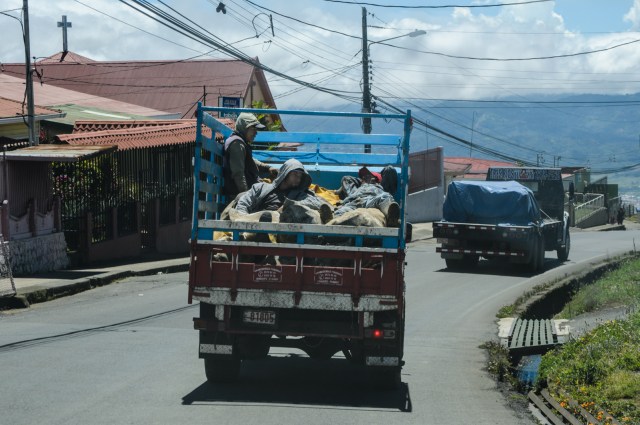3 or 4 passable shots from the D7000, and only 3 or 4 (or 5).
Even given the technical difficulties I experienced with the digital rig, I expected a better hit ratio than I got: 1/100 is better than what a good photographer might hope for,* but if I’ve revealed anything on this blog it must be obvious that I don’t much care about sharing only good pictures…
All of these were taken on my only day out of San Juan/Heredia. Alex Jara (one of the original team members in CR) took me to Cartago, to the Irazú volcano, the Sanatorio (pictured, unfocused, earlier today), the Basilica of Our Lady of the Angels in Cartago, and the Jardín Botánico Lankester. It’s a real shame the camera failed so badly at the last one… it was camera club day at the botanical gardens, and I saw and shot a number of really fun streetog-type shots of dozens of photographers shooting hither and yon. Alas: things were not focused properly.
It was cold and foggy at the Volcano, and thus hard to take pictures (or see much at all). But Allah azza wa jall made it so sunlight+water vapor=rainbows, and so the crater was pretty much one big rainbow (see above).
On our way back down the mountain, we stopped at this abutment overlooking the Sanatorio, where I snagged this picture of a flower.
Not, admittedly, my best work.
Further down the mountain, and after a lunch of Sopa Negra con huevos—black soup (liquid from cooking black beans) with an egg poached in: sort of the Tico equivalent of chicken noodle soup—we fell in behind this truck. I liked the look of the guy lounging in the back. I think they all came from picking lettuces or something farther up the hill.
From this, you can see a bit better the trouble I had: too contrasty. Maybe I’m just too used to shooting film? Allahu Alim. But this shot, like so many others, was just way too contrasty to be of any value to me. (I did note that the 28-105 D was contrasty… but this is too much, for my purposes, at this time.)
Anyway.
This last one is of a little brook in the Japanese portion of Lankaster Garden. I didn’t have ND filters, so I used the old narrow aperture trick to get slightly slower shutter speed. Good times.
f/29? Yep. That got me a 1/10th shutter speed, enough to get a bit of blur on the water.
And there you go: the sum total of usable shots from the D7000 on this trip.
I might one day revisit and do all the HDRs and panoramas I set up. But for now, let’s move out of the digital realm and into the analog.**
*”Eugene Smith was a fair match for Cartier-Bresson in finely honed irony. At one point in a heated exchange of views, Smith asked, ‘And you, Henri, how many good pictures—really good pictures—do you think you’ve taken in your life?’ …Cartier-Bresson opted for an ostentatiously modest total: ‘I should say about twelve. Perhaps only ten’. To which Smith retorted with an impetuous: ‘The hell you have! What an exaggeration! At most, you’ve done three really good pictures. No more than three.” Quoted in Fontcuberta, Joan. “The Genie of the Wonderful Camera” in Pandora’s Camera: Photogr@phy after Photography (London: Mack, 2014), 46.
**One of the points Joan Fontcuberta makes over and over again in the essays in Pandora’s Camera: Photogr@phy after Photography is that digital imaging is a completely different beast than analog photography.
Digital photography retains very little of photography in terms of its genealogical patterns. It would be more accurate to call it ‘figurative infographics’ or ‘digital realist painting’, or better yet invent some specific term or catchy acronym. There is a bigger semantic difference between analogue and digital photography than between film and video, and no one would think of calling video ‘electronic cinema’ or ‘magnetic tape cinema.’ The persistence of the word photography distorts our expectations. Or if you prefer, what distorts them is the fact that we us a noun and not an adjective—a substance and not an attribute, essence rather than quality. It is really hard to assign the appropriate name to everything when our vocabulary has already been tainted by the interests of industry, advertising, the complicity of the mass media, and our own intellectual sloth. Meanwhile, as we wait for an angel to announce how we should baptise this new concept correctly, why do we call it love when we mean sex?
Fontcuberta. “Why Call it Love when we mean Sex?” in Pandora’s Camera, 188.
Just wait till you see the pictures I snagged with the Lomo LC-A and some cheap (and not so cheap) film. The digital camera(s) have nothing on it.





